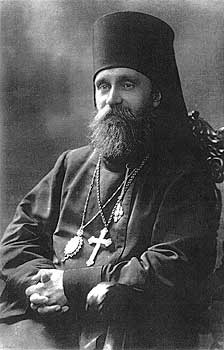Platon Kulbusch facts for kids
Platon, whose birth name was Paul Kulbusch, was an important Estonian religious leader. He was born on July 25, 1869, and passed away on January 14, 1919. Platon became the first Orthodox saint who was Estonian. A saint is someone recognized by the church for their special holiness.
Contents
Early Life and Education
Paul Kulbusch was born on July 25, 1869, in Pootsi, a place in what is now southwest Estonia. At that time, Estonia was part of Imperial Russia.
Paul was a bright student. In 1894, he finished his studies at the St. Petersburg Theological Academy. He earned a master's degree there.
Becoming a Priest
Soon after graduating, Paul Kulbusch became a priest. He served at the Estonian Orthodox Church of Saint Isidore in St. Petersburg. As a priest, he helped the church grow. He oversaw the building of new church facilities. He also worked to connect with the Anglican church.
A Time of Change
In 1917, a big meeting of church leaders took place in Riga. This meeting was called a plenary council. At this council, Paul Kulbusch was chosen to become a bishop. A bishop is a high-ranking church leader.
He was made Bishop Platon on December 31, 1917. This was a very difficult time in history.
World War and Independence
World War I was happening all over the world. Russia's emperor, Nicholas II, had been overthrown. Estonia, Platon's home country, wanted to be independent. Platon strongly supported Estonia's wish for freedom.
Russian troops left Estonia because of the threat of German invasion. This allowed Estonia to declare its independence on February 24, 1918. But this freedom was short-lived. Just days later, German forces occupied Estonia.
During the German occupation, Bishop Platon traveled a lot. He visited many church communities across Estonia. He often traveled by horse to reach them.
Arrest and Martyrdom
In November 1918, the German Revolution happened. Germany then gave political power back to the Estonian government. However, Bolshevik Russia soon invaded Estonia. They wanted to take control of the country again.
At this time, Platon was in Tartu, a city in Estonia. He had become ill with pneumonia. The Bolsheviks took over Tartu on December 24. On January 2, Platon was arrested and put in prison. He was held in a cellar.
On January 14, 1919, a sad event occurred. Bishop Platon was executed by the Bolsheviks. Two other priests, Michael Bleive and Nikolai Bezhanitsky, were also killed with him. This happened just before the Estonian Army took back the city of Tartu.
Becoming a Saint
Platon and the two other priests were later recognized as martyrs. A martyr is someone who dies for their beliefs. They were made saints by the Russian Orthodox Church in exile in 1982. Later, they were also recognized by the main Russian Orthodox Church on August 12, 2000, and by the Patriarchate of Constantinople on September 15, 2000.


